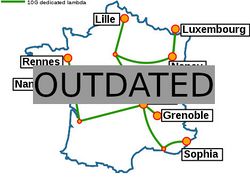Grid5000:Home: Difference between revisions
No edit summary |
No edit summary |
||
| Line 29: | Line 29: | ||
<br> | <br> | ||
== Random pick of publications == | |||
{{#publications:}} | {{#publications:}} | ||
Revision as of 12:49, 23 March 2018
|
Grid'5000 is a large-scale and versatile testbed for experiment-driven research in all areas of computer science, with a focus on parallel and distributed computing including Cloud, HPC and Big Data. Key features:
|
Random pick of publications
Five random publications that benefited from Grid'5000 (at least 2925 overall):
- Imran Ahamad Sheikh, Emmanuel Vincent, Irina Illina. Training RNN Language Models on Uncertain ASR Hypotheses in Limited Data Scenarios. Computer Speech and Language, 2024, 83, pp.101555. 10.1016/j.csl.2023.101555. hal-03327306v2 view on HAL pdf
- Jan Aalmoes. Intelligence artificielle pour des services moraux : Concilier équité et confidentialité. Intelligence artificielle cs.AI. INSA de Lyon, 2024. Français. NNT : 2024ISAL0126. tel-05014177 view on HAL pdf
- Pierre-Etienne Polet. Portage des chaînes de traitement sonar sur architecture hétérogène : conception et évaluation d'un environnement de programmation basé sur les tâches moldables. Informatique cs. Ecole normale supérieure de lyon - ENS LYON, 2024. Français. NNT : 2024ENSL0004. tel-04633261 view on HAL pdf
- Cédric Prigent, Melvin Chelli, Alexandru Costan, Loïc Cudennec, René Schubotz, et al.. Efficient Resource-Constrained Federated Learning Clustering with Local Data Compression on the Edge-to-Cloud Continuum. HiPC 2024 - 31st IEEE International Conference on High Performance Computing, Data, and Analytics, Dec 2024, Bengaluru (Bangalore), India. pp.1-11, 10.1109/HiPC62374.2024.00033. hal-04779813 view on HAL pdf
- Fatmir Asllanaj, Sylvain Contassot-Vivier, Guilherme C Fraga, Francis H.R. França, Roberta J.C. da Fonseca. New gas radiation model of high accuracy based on the principle of weighted sum of gray gases. Journal of Quantitative Spectroscopy and Radiative Transfer, 2024, 315, pp.108887. 10.1016/j.jqsrt.2023.108887. hal-04375649 view on HAL pdf
Latest news
Failed to load RSS feed from https://www.grid5000.fr/mediawiki/index.php?title=News&action=feed&feed=atom: Error parsing XML for RSS
Grid'5000 sites
Current funding
As from June 2008, Inria is the main contributor to Grid'5000 funding.
INRIA |
CNRS |
UniversitiesUniversité Grenoble Alpes, Grenoble INP |
Regional councilsAquitaine |


